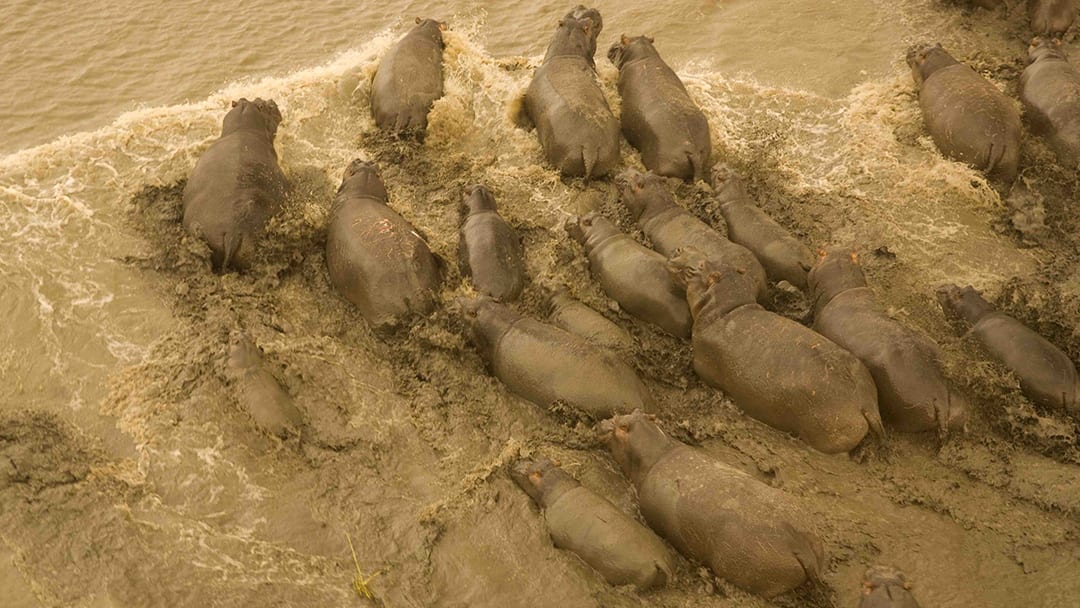Hippos

Gorongosa turns into a virtual water world during the rainy season and that is good for our hippos! Gorongosa was home to about 3,500 hippos in the 1970’s and they did a good job mowing the grasses of the Lake Urema floodplain. Today Gorongosa has already over 750 hippos which represents a good increase over the 100 hippos remaining in the year 2000.
Hippos weigh up to 3.5 tons, which makes them the third-largest land mammal in the world after elephants and white rhinos. Hippos are amphibious – they spend most of their day resting and socializing in the water, and most of the night eating grass on land. An adult hippo can walk up to 5 miles or more from the water looking for food and they eat 20-40 kg of grass every night. Their huge sharp canine teeth are used for self-defense and for fighting other hippos, not for eating. When they eat, they pull grass out of the ground with their lips and chew it with their large molars.
Life in the Water
During the day, hippos can get sunburned! They need to be submerged in water most of the day to protect their sensitive skin from the sun. They also secrete a unique substance from their skin, which is reddish-orange in color and acts as both a sunscreen and an antibiotic. Hippos can sleep while they’re in the water – if the water is too deep for them to rest on their feet, they have a reflex that allows them to shut their nostrils, ears, and eyes, sink slowly to the bottom, push off, rise to the surface, take a breath, and do it all again – all while sleeping.
Hippos Communities
During the day, hippos live in groups of related females and their young, overseen by an unrelated bull. Hippo pods are extremely fluid – new members come and go all the time. Hippos are territorial in the water but only during the day. At night, they wander to look for food on land and are not territorial. It is rare for predators to prey on hippos – most hippos die of natural causes or are killed by other hippos in fights. Crocs have been known to take young hippos if they become isolated from the pod, and lions will occasionally kill adults if they can snatch them while they’re out of the water.

Ecosystem Engineers
Hippos are ecosystem engineers – that means that they create and change the land in and around wetlands. They do this by moving a lot of soil around with their sheer size – they create channels in the water and paths on land that redirect water. This also creates habitat and shelter for smaller creatures. Hippos also play an important role in the wetland by fertilizing the water. By eating on land and pooping in the water, they bring nutrients to rivers and lakes that wouldn’t otherwise be there, helping enrich wetland plant and animal life.
Hippo Conservation
Hippos were found all across sub-Saharan Africa over the last century, but now they’re restricted to very limited areas. Competition with humans over water and space has been the biggest factor in their shrinking range. Illegal hunting and retaliatory killing (for crop damage or attacks on humans) has also contributed to their decline. As hippos decline, wetlands are suffering because hippos are critical to wetland ecosystems.

Gorongosa’s hippos experienced a sharp decline from their population of 3,500 in the 1970’s but with increased protection, the population is rebounding from 100 hippos in the year 2000 to over 750 hippos today. Research on Gorongosa’s hippos is underway to better understand how Gorongosa’s wetlands are doing with fewer hippos. With increased protection and a better understanding of our hippo population, recovery of Gorongosa’s magnificent hippos is off to a good start.
Our Mission
Our Mission
Advance an integrated multi-partner approach to conservation and to people-centred development. The Gorongosa Project protects the Park’s biodiversity and ecosystem services and unlocks its economic potential for the community inhabitants of the Gorongosa Buffer Zone, Sofala Province, Mozambique and further afield.
Our Vision
A thriving, biodiversity-rich, Greater Gorongosa conservation landscape, which supports Sofala Province as an engine for resilient and sustainable development enabling nature experiences and wellbeing for its people, enriching all of Mozambique and the world.
A Park for Peace
On 1 August, 2019 a historic ceremony was held in Gorongosa to celebrate the Cessation of Hostilities Accord between the leaders of the Government of Mozambique and the opposition Renamo Party. The accord established Gorongosa National Park (GNP) as a ‘Park for Peace’, delivering human development to the communities that share the greater landscape.